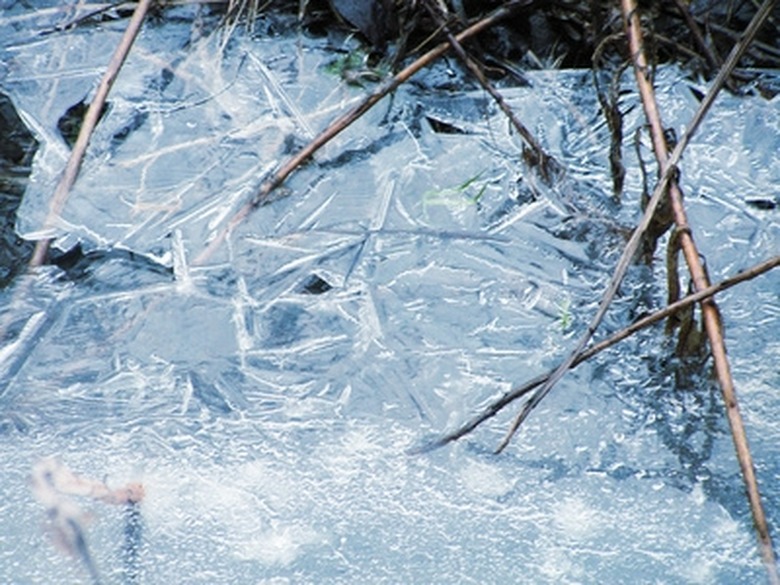How Does Water Freeze?
Freezing And Molecular Motion
Freezing And Molecular Motion
When water freezes it usually passes from the liquid to the solid state. As a liquid, water molecules are in constant motion, bumping and jostling each other and never staying in one place for long. When water freezes, the molecules slow and settle into place, lining up in regular formations you see as crystals. For pure water, the temperature must drop to 32 degrees Fahrenheit (zero degrees Celsius) for this to happen. For any substance, the temperature at which freezing occurs depends on forces that make its molecules stick together.
Sticky Molecules And Freezing Point
Sticky Molecules And Freezing Point
All molecules and atoms have forces that attract one to the other. Some atoms, such as carbon, hold on to each other very strongly; others, such as helium, have very little attractive force. Substances with strong attractive forces freeze at thousands of degrees Fahrenheit, whereas those whose forces are weak, such as nitrogen, freeze at very frigid temperatures. The attraction between water molecules is moderate — neither weak nor powerful — so water freezes at a modest 32 degrees Fahrenheit.
Freezing Point Depression
Freezing Point Depression
If you add other substances to water, such as sugar or salt, the temperature drops below 32 degrees before ice begins to form. The new freezing point depends on the added substance and how much you mix with water, and this is why cities put salt on the roads in some states to remove ice and snow in the winter. As another example, vodka, a mixture of water and alcohol, stays liquid for an extended period when kept in a freezer. The alcohol in the vodka lowers the freezing point significantly.
Freezing, Expansion And Crystal Formation
Freezing, Expansion And Crystal Formation
Most substances contract, or shrink, in volume as they get cold. Water only contracts until it is lowered to 39 degrees; at colder temperatures, it begins to expand. As the water gets colder, its molecules slow down and arrange themselves such that gaps exist between groups of molecules. As they get colder, the molecules form hexagonal patterns that eventually become snowflakes and related crystals.
Force Of Ice Expansion
Force Of Ice Expansion
If you fill a bottle completely filled with water, then seal it with a lid before putting it into a freezer, the water expands as it gets colder. Eventually, the ice will burst the bottle. This is true even for containers made of strong materials such as iron; the pressure exerted by freezing water is as high as 40,000 psi at minus 7.6 degrees Fahrenheit (minus 22 degrees Celsius).
References
- Argonne National Laboratory: Water Expansion Pressure
- http://chemwiki.ucdavis.edu/Physical_Chemistry/Quantum_Mechanics/Atomic_Theory/Intermolecular_Forces/London_Dispersion_Interactions
Cite This Article
MLA
Johnson, Ann. "How Does Water Freeze?" sciencing.com, https://www.sciencing.com/water-freeze-4600114/. 24 April 2017.
APA
Johnson, Ann. (2017, April 24). How Does Water Freeze?. sciencing.com. Retrieved from https://www.sciencing.com/water-freeze-4600114/
Chicago
Johnson, Ann. How Does Water Freeze? last modified March 24, 2022. https://www.sciencing.com/water-freeze-4600114/
